Publications
The following list contains publications that describe Gwyddion, its architecture, individual components, algorithms, and other parts of the ‘Gwyddion ecosystem’ or are related to the software in some other fundamental manner.
The goal is not to gather here all papers mentioning that Gwyddion was used for data analysis. Such papers, while gratifying and encouraging further development of the software, are quite a few and you can get them Scopus, Web of Science or a similar database if you are interested. A list of publications where Gwyddion was utilised may be added in future if we figure out how to manage such thing reasonably.
Generally, the list contains publications by Gwyddion contributors about things inherently gwyddionic. But third party publications are not excluded. For instance papers describing a data analysis system built on top of Gwyddion libraries or third-party extension modules can be good candidates for inclusion. If you think your publication should be mentioned here please do not hesitate to contact us.
Books and book chapters
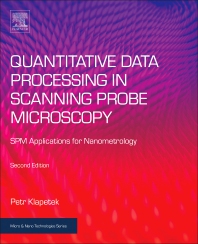
Quantitative Data Processing in Scanning Probe Microscopy, 2nd edition
Petr Klapetek et al.
Elsevier 2018, ISBN: 978-0-12-813347-7
Publisher's store link: Quantitative Data Processing in Scanning Probe Microscopy, 2nd edition
Table of contents:
1. Motivation
2. Instrumentation Principles
3. Data Models
4. Basic Data Processing
5. Dimensional Measurements
6. Force and Mechanical Properties
7. Friction and Lateral Forces
8. Electrostatic Fields
9. Magnetic Fields
10. Local Current Measurements
11. Thermal Measurements
12. Optical Measurements
13. Sample Data Files
14. Numerical Modelling Techniques
The book is accompanied with freely available sample data.
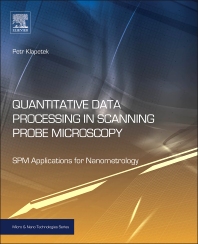
Quantitative Data Processing in Scanning Probe Microscopy
Petr Klapetek et al.
William Andrew 2012, ISBN: 978-1-4557-3058-2
Publisher's store link: Quantitative Data Processing in Scanning Probe Microscopy
Table of contents:
1. Motivation
2. Instrumentation Principles
3. Data Models
4. Basic Data Processing
5. Dimensional Measurements
6. Force and Mechanical Properties
7. Friction and Lateral Forces
Papers in scientific journals
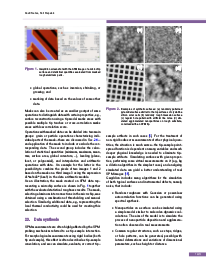
Gwyddion: an open-source software for SPM data analysis
David Nečas and Petr Klapetek
Central European Journal of Physics 10 (2012) 181–188
DOI: 10.2478/s11534-011-0096-2
Abstract: In this article, we review special features of Gwyddion—a modular, multiplatform, open-source software for scanning probe microscopy data processing, which is available at https://gwyddion.net/. We describe its architecture with emphasis on modularity and easy integration of the provided algorithms into other software. Special functionalities, such as data processing from non-rectangular areas, grain and particle analysis, and metrology support are discussed as well. It is shown that on the basis of open-source software development, a fully functional software package can be created that covers the needs of a large part of the scanning probe microscopy user community.
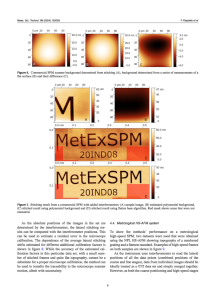
Stitching accuracy in large area Scanning Probe Microscopy
Petr Klapetek, David Nečas, Edward Heaps, Bruno Sauvet, Vojtěch Klapetek, Miroslav Valtr, Virpi Korpelainen and Andrew Yacoot
Measurement Science and Technology 35 (2024) 125026
Abstract: Image stitching is a technique that can significantly enlarge the scan area of Scanning Probe Microscope (SPM) images. It is also the most commonly used method to cover large areas in high-speed SPM. In this paper we provide details on stitching algorithms developed specifically to mitigate the effects of SPM error sources, namely the presence of scanner non-flatness. Using both synthetic data and flat samples we analyse the potential uncertainty contributions related to stitching, showing that the drift and line mismatch are the dominant sources of uncertainty. We also present the ``flatten base'' algorithm that can significantly improve the stitched data result, at costs of losing the large area form information about the sample.

Self-consistent autocorrelation for finite-area bias correction in roughness measurement
David Nečas
Engineering Research Express 6 (2024) 025560
Abstract: Scan line levelling, a ubiquitous and often necessary step in AFM data processing, can cause a severe bias on measured roughness parameters such as mean square roughness or correlation length. Although bias estimates have been formulated, they aimed mainly at assessing the severity of the problem for individual measurements. Practical bias correction methods are still missing. This work exploits the observation that the bias of autocorrelation function (ACF) can be expressed in terms of the function itself, permitting a self-consistent formulation. From this two correction approaches are developed, both with the aim to obtain convenient formulae which can be easily applied in practice. The first modifies standard analytical models of ACF to incorporate, in expectation, the bias and thus actually match the data the models are used to fit. The second inverts the relation between true and estimated ACF to realise a model-free correction. Both are tested using simulated and experimental data and found effective, reducing the total error of roughness parameters several times in the typical cases.
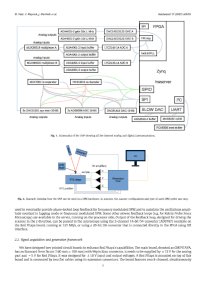
Scanning Probe Microscopy controller with advanced sampling support
Miroslav Valtr, Petr Klapetek, Jan Martinek, Ondřej Novotný, Zdeněk Jelínek, Václav Hortvík and David Nečas
Hardware X 15 (2023) e00451
DOI: 10.1016/j.ohx.2023.e00451
Abstract: A low-cost Digital Signal Processor (DSP) unit for advanced Scanning Probe Microscopy measurements is presented. It is based on Red Pitaya board and custom built electronic boards with additional high bit depth AD and DA converters. By providing all the necessary information (position and time) with each data point collected it can be used for any scan path, using either existing libraries for scan path generation or creating adaptive scan paths using Lua scripting interface. The DSP is also capable of performing statistical calculations, that can be used for decision making during scan or for the scan path optimisation on the DSP level.

Demystifying data evaluation in the measurement of periodic structures
David Nečas, Andrew Yacoot, Miroslav Valtr and Petr Klapetek
Measurement Science and Technology 34 (2023) 055015
Abstract: Periodic structures are often found in various areas of nanoscience and nanotechnology with many of them being used for metrological purposes either to calibrate instruments, or forming the basis of measuring devices such as encoders. Evaluating the period of one or two-dimensional periodic structures from topography measurements, e.g. performed using scanning probe microscopy, can be achieved using different methodologies with many grating evaluation methods having been proposed in the past and applied to a handful of examples. The optimum methodology for determining the grating period/pitch is not immediately obvious. This paper reports the results of extensive large-scale simulations and analysis to evaluate the performance of both direct and Fourier space data processing methods. Many thousands of simulations have been performed on a variety of different gratings under different measurement conditions and including the simulation of defects encountered in real life situations. The paper concludes with a summary of the merits and disadvantages of the methods together with practical recommendations for the measurements of periodic structures and for developing algorithms for processing them.

Synthetic Data in Quantitative Scanning Probe Microscopy
David Nečas and Petr Klapetek
Nanomaterials 11 (2021) 1746
DOI: 10.3390/nano11071746
Abstract: Synthetic data are of increasing importance in nanometrology. They can be used for development of data processing methods, analysis of uncertainties and estimation of various measurement artefacts. In this paper we review methods used for their generation and the applications of synthetic data in scanning probe microscopy, focusing on their principles, performance, and applicability. We illustrate the benefits of using synthetic data on different tasks related to development of better scanning approaches and related to estimation of reliability of data processing methods. We demonstrate how the synthetic data can be used to analyse systematic errors that are common to scanning probe microscopy methods, either related to the measurement principle or to the typical data processing paths.
Algorithms for using silicon steps for scanning probe microscope evaluation
Jørgen Garnæs, David Nečas, Lars Nielsen, Morten Hannibal Madsen, Antoni Torras-Rosell, Guanghong Zeng, Petr Klapetek and Andrew Yacoot
Metrologia 57 (2020) 064002
Abstract: The 2019 update to the Mise en Pratique for the metre adopted the lattice parameter of silicon as a secondary realisation of the metre for dimensional nanometrology. One route for this realisation is the use of amphitheatre like monoatomic steps of silicon. In response, in this paper we present new algorithms for one- and two-dimensional analysis of atomic force microscope images of these large area atomic terraces on the surface of silicon. These algorithms can be used to determine the spacing between the steps and identify errors in AFM scanning systems. Since the vertical separation of the steps is of the same order of magnitude as many errors associated with AFMs great care is needed in processing AFM measurements of the steps. However, using the algorithms presented in this paper, corrections may be made for AFM scanner bow and waviness as well as taking into account the edge eects on the silicon steps. Applicability of the data processing methods is demonstrated on data sets obtained from various instruments. Aspects of steps arrangement on surface and its impact on uncertainties are discussed as well.

How levelling and scan line corrections ruin roughness measurement and how to prevent it
David Nečas, Miroslav Valtr and Petr Klapetek
Scientific Reports 10 (2020) 15294
DOI: 10.1038/s41598-020-72171-8
Abstract: Surface roughness plays an important role in various fields of nanoscience and nanotechnology. However, the present practices in roughness measurements, typically based on some Atomic Force Microscopy measurements for nanometric roughness or optical or mechanical profilometry for larger scale roughness significantly bias the results. Such biased values are present in nearly all the papers dealing with surface parameters, in the areas of nanotechnology, thin films or material science. Surface roughness, most typically root mean square value of irregularities Sq is often used parameter that is used to control the technologies or to link the surface properties with other material functionality. The error in estimated values depends on the ratio between scan size and roughness correlation length and on the way how the data are processed and can easily be larger than 10% without us noting anything suspicious. Here we present a survey of how large is the problem, detailed analysis of its nature and suggest methods to predict the error in roughness measurements and possibly to correct them. We also present a guidance for choosing suitable scan area during the measurement.
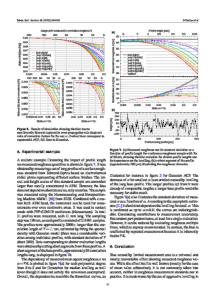
Estimation of roughness measurement bias originating from background subtraction
David Nečas, Petr Klapetek and Miroslav Valtr
Measurement Science and Technology 31 (2020) 094010
Abstract: When measuring the roughness of rough surfaces, the limited sizes of scanned areas lead to its systematic underestimation. Levelling by polynomials and other filtering used in real-world processing of atomic force microscopy data increases this bias considerably. Here a framework is developed providing explicit expressions for the bias of squared mean square roughness in the case of levelling by fitting a model background function using linear least squares. The framework is then applied to polynomial levelling, for both one-dimensional and two-dimensional data processing, and basic models of surface autocorrelation function, Gaussian and exponential. Several other common scenarios are covered as well, including median levelling, intermediate Gaussian–exponential autocorrelation model and frequency space filtering. Application of the results to other quantities, such as Rq, Sq, Ra and Sa is discussed. The results are summarized in overview plots covering a range of autocorrelation functions and polynomial degrees, which allow graphical estimation of the bias.
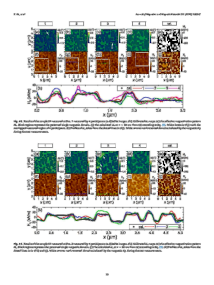
Round robin comparison on quantitative nanometer scale magnetic field measurements by magnetic force microscopy
Xiukun Hu, Gaoliang Dai, Sibylle Sievers, Alexander Fernández-Scarioni, Héctor Corte-León, Robert Puttock, Craig Barton, Olga Kazakova, Michal Ulvr, Petr Klapetek, Marek Havlíček, David Nečas, Yuanjun Tang, Volker Neu and Hans Werner Schumacher
Journal of Magnetism and Magnetic Materials 511 (2020) 166947
DOI: 10.1016/j.jmmm.2020.166947
Abstract: Magnetic force microscopy (MFM) can be considered as a standard tool for nano-scale investigation of magnetic domain structures by probing the local stray magnetic field landscape of the measured sample. However, this generally provides only qualitative data. To quantify the stray magnetic fields, the MFM system must be calibrated. To that end, a transfer function (TF) approach was proposed, that, unlike point probe models, fully considers the finite extent of the MFM tip. However, albeit being comprehensive, the TF approach is not yet well established, mainly due to the ambiguities concerning the input parameters and the measurement procedure. Additionally, the calibration process represents an ill-posed problem which requires a regularization that introduces further parameters. In this paper we propose a guideline for quantitative stray field measurements by standard MFM tools in ambient conditions. All steps of the measurement and calibration procedure are detailed, including reference sample and sample under test (SUT) measurements and the data analysis. The suitability of the reference sample used in the present work for calibrated measurements on a sub-micron scale is discussed. A specific regularization approach based on a Pseudo-Wiener Filter is applied and combined with criteria for the numerical determination of a unique regularization parameter. To demonstrate the robustness of such a defined approach, a round robin comparison of magnetic field measurements was conducted by four laboratories. The guidelines, the reference sample and the results of the round robin are discussed.

Determination of tip transfer function for quantitative MFM using frequency domain filtering and least squares method
David Nečas, Petr Klapetek, Volker Neu, Marek Havlíček, Robert Puttock, Olga Kazakova, Xiukun Hu and Lenka Zajíčková
Scientific Reports 9 (2019) 3880
DOI: 10.1038/s41598-019-40477-x
Abstract: Magnetic force microscopy has unsurpassed capabilities in analysis of nanoscale and microscale magnetic samples and devices. Similar to other Scanning Probe Microscopy techniques, quantitative analysis remains a challenge. Despite large theoretical and practical progress in this area, present methods are seldom used due to their complexity and lack of systematic understanding of related uncertainties and recommended best practice. Use of the Tip Transfer Function (TTF) is a key concept in making Magnetic Force Microscopy measurements quantitative. We present a numerical study of several aspects of TTF reconstruction using multilayer samples with perpendicular magnetisation. We address the choice of numerical approach, impact of non-periodicity and windowing, suitable conventions for data normalisation and units, criteria for choice of regularisation parameter and experimental effects observed in real measurements. We present a simple regularisation parameter selection method based on TTF width and verify this approach via numerical experiments. Examples of TTF estimation are shown on both 2D and 3D experimental datasets. We give recommendations on best practices for robust TTF estimation, including the choice of windowing function, measurement strategy and dealing with experimental error sources. A method for synthetic MFM data generation, suitable for large scale numerical experiments is also presented.
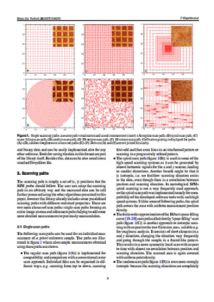
Gwyscan: a library to support non-equidistant Scanning Probe Microscope measurements
Petr Klapetek, Andrew Yacoot, Petr Grolich, Miroslav Valtr and David Nečas
Measurement Science and Technology 28 (2017) 034015
DOI: 10.1088/1361-6501/28/3/034015
Abstract: We present a software library and related methodology for enabling easy integration of adaptive step (non-equidistant) scanning techniques into metrological scanning probe microscopes or scanning probe microscopes where individual x, y position data are recorded during measurements. Scanning with adaptive steps can reduce the amount of data collected in SPM measurements thereby leading to faster data acquisition, a smaller amount of data collection required for a specific analytical task and less sensitivity to mechanical and thermal drift. Implementation of adaptive scanning routines into a custom built microscope is not normally an easy task: regular data are much easier to handle for previewing (e.g. levelling) and storage. We present an environment to make implementation of adaptive scanning easier for an instrument developer, specifically taking into account data acquisition approaches that are used in high accuracy microscopes as those developed by National Metrology Institutes. This includes a library with algorithms written in C and LabVIEW for handling data storage, regular mesh preview generation and planning the scan path on basis of different assumptions. A set of modules for Gwyddion open source software for handling these data and for their further analysis is presented. Using this combination of data acquisition and processing tools one can implement adaptive scanning in a relatively easy way into an instrument that was previously measuring on a regular grid. The performance of the presented approach is shown and general non-equidistant data processing steps are discussed.
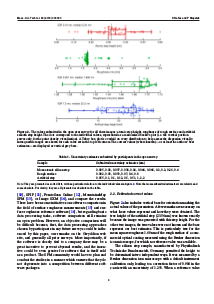
Study of user influence in routine SPM data processing
David Nečas and Petr Klapetek
Measurement Science and Technology 27 (2017) 034014
DOI: 10.1088/1361-6501/28/3/034014
Abstract: The quantitative results obtained using scanning probe microscopy (SPM) are influenced not only by instrumentation factors, but also humans—the SPM users that perform the data processing and the evaluation of statistics, dimensions and other parameters from the images. We investigate this user influence empirically by performing several experiments in which real humans process SPM data in different settings using the same software, and statistically characterise the results. Two types of experiments are conducted: one in a well-defined laboratory setting where prescribed procedures requiring user input are applied by experienced users to large ensembles of similar data; the other in an open setting in which a large group of SPM users evaluate the same images to obtain specified parameters but without external guidance. The open study in particular brings about results that should be alarming for the SPM community and SPM metrology in particular. We also attempt to derive some guidance for the design of SPM data processing software functions from the results and classify the amount of user input in the data processing functions.
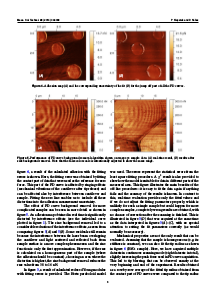
Independent analysis of mechanical data from atomic force microscopy
Petr Klapetek and David Nečas
Measurement Science and Technology 25 (2014) 044009
DOI: 10.1088/0957-0233/25/4/044009
Abstract: Present atomic force microscopes are capable of acquiring large data volumes by point using point force-distance spectroscopic measurements. Even if different trade names and different technical implementations are used, for most of these techniques a force-distance curve in every image pixel is measured, this curve is immediately fitted by some theoretical dependency and results are displayed as a mechanical properties channel (Young modulus, adhesion, etc.). Results are processed during the measurement directly in the SPM controller or, after it, by manufacturer provided software. In this article we present a software tool for independent numerical processing of such data, including more numerical models for force distance curves evaluation and including a simple estimate of uncertainties related with fitting procedure. This can improve the reliability and the analytical possibilities of mechanical properties mapping methods in atomic force microscopy.

One-dimensional autocorrelation and power spectrum density functions of irregular regions
David Nečas and Petr Klapetek
Ultramicroscopy 124 (2013) 13-19
DOI: 10.1016/j.ultramic.2012.08.002
Abstract: Scanning probe microscopy (SPM) can be effectively used for evaluation of nanoscale roughness of surfaces obtained by different technological processes. Spectral properties of surface roughness can be evaluated using algorithms based on Fast Fourier Transform (FFT). For data that are not rectangular, this approach, however fails. In this article we describe a modification of SPM data evaluation algorithms enabling to use FFT based approach even for irregular and non-continuous data. This opens novel possibilities in analysis of local surface roughness in many fields, e.g. on nanoparticles, semiconductor structures or any other nanostructured samples prepared using nanotechnology methods. Together with theoretical description of proposed method we present benchmarks for its performance and typical results of its application on different samples.

Methods for determining and processing 3D errors and uncertainties for AFM data analysis
Petr Klapetek, David Nečas, Anna Campbellová, Andrew Yacoot and Ludger Koenders
Measurement Science and Technology 22 (2011) 025501
DOI: 10.1088/0957-0233/22/2/025501
Abstract: This paper describes the processing of three-dimensional (3D) scanning probe microscopy (SPM) data. It is shown that 3D volumetric calibration error and uncertainty data can be acquired for both metrological atomic force microscope systems and commercial SPMs. These data can be used within nearly all the standard SPM data processing algorithms to determine local values of uncertainty of the scanning system. If the error function of the scanning system is determined for the whole measurement volume of an SPM, it can be converted to yield local dimensional uncertainty values that can in turn be used for evaluation of uncertainties related to the acquired data and for further data processing applications (e.g. area, ACF, roughness) within direct or statistical measurements. These have been implemented in the software package Gwyddion.
